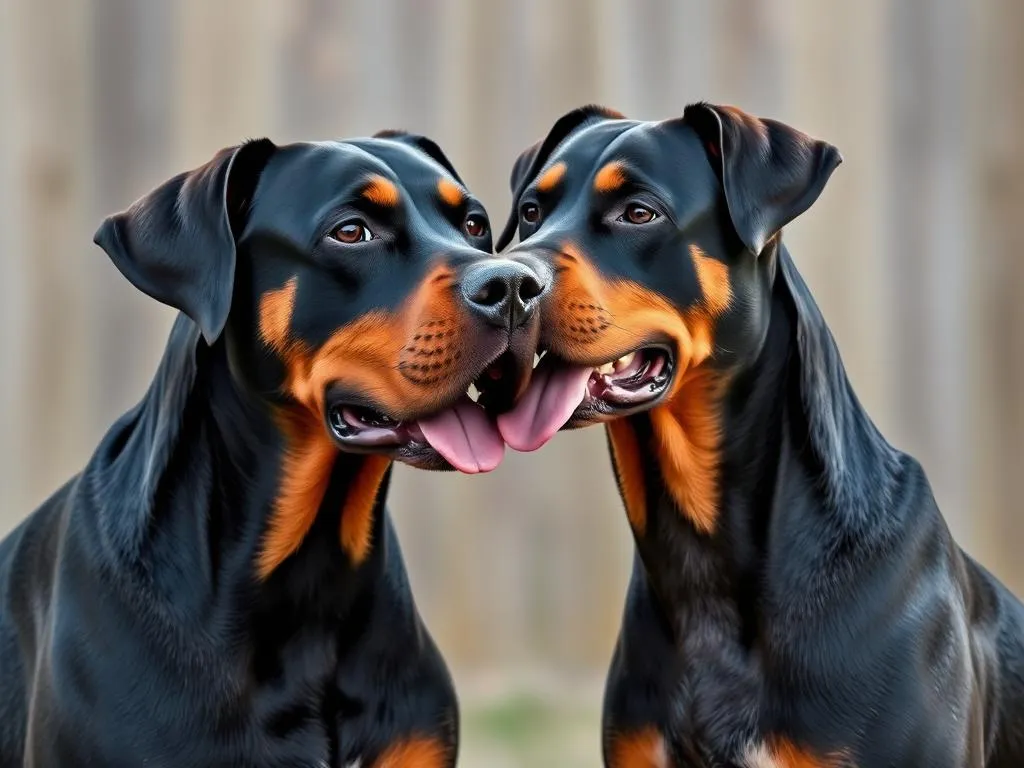
Choosing the right dog breed is crucial for any potential dog owner. Two of the most popular breeds that often come up in discussions are the Doberman and the Rottweiler. Both breeds have rich histories, distinct physical characteristics, unique temperaments, and specific needs when it comes to training, exercise, grooming, and health. By comparing Doberman vs Rottweiler across various aspects, we can help you make an informed decision that aligns with your lifestyle.
Breed History
Doberman History
The Doberman breed originated in the late 19th century in Germany, primarily developed by a tax collector named Karl Friedrich Louis Dobermann. He sought to create a loyal and protective companion that could assist him in his duties. Consequently, the Doberman was bred using various breeds, including the German Pinscher, Rottweiler, Greyhound, and Weimaraner.
Historically, Dobermans served various functions, including guard dogs, police dogs, and even military dogs due to their keen intelligence and loyalty. Their natural protective instincts made them ideal for roles that required vigilance and courage. Key characteristics that were bred into Dobermans include alertness, strength, and an unwavering loyalty to their owners.
Rottweiler History
The Rottweiler has a storied past that dates back to the Roman Empire, where they were used as herding dogs and for pulling carts. The breed’s name is derived from the town of Rottweil in Germany, where these dogs were primarily used to herd livestock and protect cattle.
Over time, Rottweilers evolved into versatile working dogs, taking on roles in various fields, including search and rescue, therapy, and as police or military dogs. Their strong, confident nature and protective instincts have made them excellent guard dogs. Today, Rottweilers are beloved family pets known for their loyalty and protectiveness.
Physical Characteristics
Doberman Physical Traits
Dobermans are medium to large-sized dogs, typically weighing between 60 to 100 pounds and standing about 24 to 28 inches tall at the shoulder. They have a sleek, muscular build that exudes strength and agility.
Their coat is short and smooth, with color variations including black, red, blue, and fawn, often accompanied by rust-colored markings. Distinctive features of Dobermans include their cropped ears and docked tails, though many now opt for natural ears and tails due to changing laws and preferences.
Rottweiler Physical Traits
Rottweilers are larger and more robust than Dobermans, weighing between 80 to 135 pounds and standing around 22 to 27 inches tall. Their muscular physique gives them a powerful appearance, ideal for their historical roles as guard and working dogs.
The Rottweiler’s coat is also short and dense, primarily black with distinctive tan markings on the face, chest, and legs. Their broad skull, sturdy build, and thick neck contribute to their strong presence, making them easily recognizable.
Temperament and Behavior
Doberman Temperament
The temperament of a Doberman is typically characterized by loyalty, intelligence, and alertness. They are known for being affectionate with their families and protective of their loved ones. Socialization is crucial for Dobermans, as it helps them distinguish between normal and suspicious behaviors, ensuring they are well-adjusted.
However, potential owners should be aware of common behavioral issues such as anxiety and aggression if not properly trained or socialized. Dobermans thrive in environments where they receive ample attention and mental stimulation.
Rottweiler Temperament
Rottweilers are confident, courageous, and protective, often forming strong bonds with their families. They are known for their loyalty and can be very affectionate with their owners. Their protective instincts make them excellent watchdogs, but this can lead to dominance or territoriality if not managed correctly.
Social behavior varies, as Rottweilers may be reserved or aloof with strangers. Like Dobermans, training and socialization are essential to prevent common behavioral issues, such as aggression or dominance.
Training and Exercise Needs
Doberman Training Requirements
Dobermans are highly intelligent and eager to please, making them relatively easy to train. Recommended training techniques include positive reinforcement methods, which encourage good behavior without fear or intimidation.
In terms of exercise, Dobermans require a significant amount – ideally, at least 1 to 2 hours of vigorous exercise daily, including walks, playtime, and mental stimulation activities. Early socialization is also critical to ensure they grow into well-rounded adults.
Rottweiler Training Requirements
Rottweilers also respond well to positive reinforcement training and benefit from consistent, firm leadership. They are intelligent but can sometimes exhibit stubbornness, so patience is essential during training.
Rottweilers typically require 1 to 2 hours of exercise each day, including walks, play, and even some structured activities like obedience training or agility. Socialization from a young age will help them become more adaptable and friendly with new experiences, people, and pets.
Health Issues and Lifespan
Doberman Health Concerns
Dobermans are generally healthy but can be prone to specific health issues. Common concerns include hip dysplasia, dilated cardiomyopathy (a heart condition), and certain types of cancers. Regular veterinary check-ups and a healthy diet can help mitigate some of these risks.
The average lifespan of a Doberman ranges from 10 to 13 years. Preventative care, such as regular exercise, a balanced diet, and routine health screenings, can contribute to a longer, healthier life.
Rottweiler Health Concerns
Rottweilers face health challenges as well, including hip and elbow dysplasia, heart conditions, and certain neurological disorders. Maintaining a healthy weight is crucial for Rottweilers, as obesity can exacerbate existing health issues.
The average lifespan of a Rottweiler is about 8 to 10 years. Preventative measures, such as regular veterinary visits, a well-balanced diet, and proper exercise, play a vital role in their overall health and longevity.
Grooming and Maintenance
Doberman Grooming Needs
Dobermans have low grooming needs due to their short coat. Regular brushing (about once a week) helps remove loose hair and dirt. They typically do not require frequent baths unless they become particularly dirty.
Other grooming considerations include regular nail trimming and ear cleaning. Since Dobermans can be prone to ear infections, monitoring their ears for signs of dirt or wax buildup is essential.
Rottweiler Grooming Needs
Rottweilers also have short coats that require minimal grooming. Brushing them weekly helps reduce shedding and keeps their coat healthy. They should be bathed as needed, typically once every few months or as they get dirty.
Regular grooming considerations include nail trimming and dental care. Rottweilers can be prone to dental issues, so establishing a routine for brushing their teeth is advisable.
Best Living Environments
Ideal Environment for Dobermans
Dobermans thrive in homes with ample space, making them more suited for houses with yards rather than apartments. They require an environment where they can engage in physical activity and mental stimulation.
Dobermans are generally good with children and can coexist with other pets if properly socialized. However, their protective instincts may require supervision around unfamiliar animals or individuals.
Ideal Environment for Rottweilers
Rottweilers also benefit from having space to roam, making a house with a yard ideal. They are adaptable and can live in various environments as long as their exercise needs are met.
These dogs can be great with children and other pets, but early socialization is crucial to ensure that they are comfortable in different situations. Rottweilers do best in homes where they are included in family activities.
Cost of Ownership
Doberman Ownership Costs
When considering a Doberman, the initial acquisition cost can range from $1,000 to $3,000, depending on the breeder or adoption fees. Ongoing costs include food, which can be around $50 to $100 monthly, grooming supplies, and routine veterinary care.
Training costs can vary widely, but investing in professional training is advisable, especially for first-time owners. This can add another $100 to $500 annually.
Rottweiler Ownership Costs
The initial acquisition cost for a Rottweiler ranges from $1,000 to $2,500, depending on the source. Monthly food expenses are similar to those for Dobermans, typically around $50 to $100.
Routine veterinary care, grooming, and training will also incur costs. Rottweiler owners should budget for training, which may run from $100 to $500 each year.
Conclusion
In the debate of Doberman vs Rottweiler, both breeds offer unique characteristics and advantages. Dobermans are known for their loyalty, intelligence, and sleek appearance, while Rottweilers are recognized for their confidence, protectiveness, and robust build.
Ultimately, the decision between these two breeds should align with your lifestyle, living situation, and personal preferences. Understanding their traits, needs, and potential challenges will help you choose the right companion for your family.









